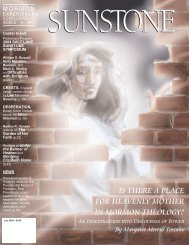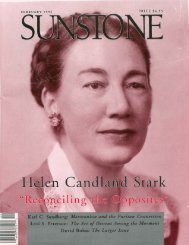Download Entire Issue PDF - Sunstone Magazine
Download Entire Issue PDF - Sunstone Magazine
Download Entire Issue PDF - Sunstone Magazine
Create successful ePaper yourself
Turn your PDF publications into a flip-book with our unique Google optimized e-Paper software.
S U N S T O N E<br />
with The First Presidency,” the Presiding Bishopric subsequently<br />
informed Wilkinson. “The occasion on which permission<br />
was given to provide you with this information as<br />
indicated by President McKay was ‘for that time only.’ The<br />
First Presidency has ruled that this information is not to be<br />
provided but rather we can give you the status of those employees<br />
as to whether they are full, part or non-tithepayers.”<br />
67<br />
By the end of 1963, Wilkinson decided to pursue a longtime<br />
dream of running for public office and stepped down as<br />
president of BYU. 68 Following his defeat and return to the<br />
BYU presidency in late 1964, his absence together with<br />
changes in the composition of the First Presidency and<br />
McKay’s failing health combined to end his surveillance of<br />
faculty tithing payments. In fact, current BYU policy strictly<br />
prohibits the release of faculty tithing information to university<br />
administrators. 69<br />
During the eight years of increased surveillance of<br />
the individual tithing records of BYU faculty members,<br />
some two dozen (probably more) teachers were dismissed<br />
or resigned specifically, according to Wilkinson,<br />
because of “religious problems,” “church problems,” or<br />
“disagreement with administration,” including “disagreement<br />
with President’s administrative approach.” 70<br />
While these numbers may not seem to represent much<br />
of an impact on BYU generally, the effect of Wilkinson’s<br />
drive to enforce adherence to LDS teachings on the<br />
lives of the individuals who left, either voluntarily or<br />
involuntarily, cannot easily be overstated. For some<br />
teachers who believed the primary criteria regarding<br />
their employment centered on academic experience and<br />
expertise, Wilkinson’s emphasis on tithing was misplaced<br />
and irrelevant. Still others, appealing to Church<br />
guidelines regarding the confidential nature of one’s<br />
tithing history, viewed Wilkinson’s interest as inappropriate.<br />
For Wilkinson, however, BYU was an extension<br />
of the Church, and he was merely an agent of the<br />
Church’s general authorities. Not only did he see<br />
nothing wrong with having access to such information,<br />
he considered it essential if he were to successfully administer<br />
the affairs of the “Lord’s University.” That such<br />
tensions endured for nearly a decade underscores the<br />
challenges confronting a religion-sponsored university<br />
and its advocates.<br />
NOTES<br />
1. For Wilkinson as president, see Gary James Bergera, “Ernest L.<br />
Wilkinson’s Appointment as Seventh President of Brigham Young University,”<br />
Journal of Mormon History 23 (Fall 1997): 128–54. For Wilkinson’s personality<br />
and managerial style, see Gary James Bergera, “Wilkinson the Man,” SUNSTONE<br />
20 (July 1997): 29–41.<br />
2. “The amount of tithing and other offerings paid by a member is confidential.<br />
Only the bishop and those who are authorized to handle such contributions<br />
should know the amount” (Handbook 1: Stake Presidents and Bishops,<br />
2010 [Salt Lake City: Church of Jesus Christ of Latter-day Saints, 2010], 128).<br />
3. Harvey Fletcher, “Autobiography,” 41, in Harvey Fletcher file,<br />
University Archives, L. Tom Perry Special Collections, Harold B. Lee Library,<br />
Brigham Young University, Provo, Utah.<br />
4. See “Tithing Record of the Faculty of the Brigham Young University for<br />
1915, Exclusive of Those Who Discontinued Service June 30,” courtesy of the<br />
Smith-Pettit Foundation.<br />
5. On the other hand, ten (15 percent) had paid more than 150 percent,<br />
and four (6 percent) had paid more than 300 percent. Ibid.<br />
6. Merrill, Letter to Presidents of LDS Church Schools, 2 May 1929, in<br />
Brigham Young University: The First One Hundred Years, 4 vols., edited by Ernest<br />
L. Wilkinson (Provo, Utah: Brigham Young University Press, 1975), 2:216.<br />
7. Merrill, Letter to Harris, 1 March 1933, in Brigham Young University:<br />
The First One Hundred Years, 2:217.<br />
8. See Howard W. Pease, “A Chronological and Comparative Listing of<br />
Events of BYU, Church and State, and National History from 1847 to 1973,” 7<br />
October 1974, in BYU Archives.<br />
9. In Brigham Young University: The First One Hundred Years, 2:218.<br />
10. Ibid., 385.<br />
11. In Franklin L. West, Letter to Christen Jensen, 9 May 1940, in Franklin<br />
L. West Papers, Perry Special Collections.<br />
12. According to BYU’s official history, “Written records do not indicate precisely<br />
what President Harris did to handle the tithing problem, but some living<br />
faculty members remember that Harris interviewed faculty members who did<br />
not pay a full tithe, reporting special problems and extenuating circumstances<br />
to the First Presidency. Where there was any doubt, President Harris usually<br />
supported the cause of the faculty member” (Brigham Young University: The<br />
First One Hundred Years, 2:218, 414). See also Janet Jenson, The Many Lives of<br />
Franklin S. Harris (Provo, Utah: BYU Printing Services, 2002), 60–63. While<br />
BYU’s official history addresses Harris’s response regarding faculty tithing, it is<br />
silent on Wilkinson’s efforts to enforce compliance, even though Wilkinson was<br />
one of the authors of the official history. For a very brief treatment of<br />
Wilkinson’s monitoring of faculty tithing, see Gary James Bergera and Ronald<br />
Priddis, Brigham Young University: A House of Faith (Salt Lake City: Signature<br />
Books, 1985), 68–70.<br />
13. Wilkinson, “Notes for Presentation to First Presidency on ‘Tithing’<br />
Problem,” 16 April 1959, Wilkinson Papers, Perry Special Collections. Unless<br />
otherwise noted, all such Wilkinson-related materials are in his papers at BYU.<br />
14. Ernest L. Wilkinson, “Memorandum of conference with President<br />
McKay Today Re: Payment of tithing by teachers,” 8 April 1957.<br />
15. The Messenger (distributed by the Presiding Bishopric of the Church of<br />
Jesus Christ of Latter-day Saints), 16 (April 1957): 2. Using more or less the<br />
same wording, this was reiterated in subsequent editions of the Church’s<br />
General Handbook of Instructions.<br />
16. Wilkinson, “Notes for Presentation to First Presidency.”<br />
17. Wilkinson, Diary, 22 April 1957.<br />
18. Wilkinson, “The Principle and Practice of Paying Tithing,” 25<br />
September 1957, 24, Perry Special Collections.<br />
19. Robert Kent Fielding, “Growing Up Mormon: Autobiographical<br />
Narratives and Related Papers,” August 1997, 20, in Robert Kent Fielding<br />
Papers, Special Collections, Marriott Library. Fielding graduated from BYU<br />
twice, in 1950 (B.A.) and again in 1952 (M.A.). Although Fielding may appear<br />
to figure more prominently than other faculty members in the following narrative,<br />
it would be a mistake to view him, or any other single faculty member, as<br />
a primary instigator of tithing-related controversies. Fielding was one of a<br />
number of faculty who disagreed with Wilkinson’s policies. If Fielding’s name<br />
appears more frequently than others, it is simply because he left an account of<br />
his involvement.<br />
20. J. Kenneth Davies, “My Personal Odyssey,” 1998, 30, courtesy of the<br />
Smith-Pettit Foundation.<br />
21. McKay, Diary, 3 March 1958, David O. McKay Papers, Special<br />
Collections, Marriott Library.<br />
22. Wilkinson, Letter to McKay, 7 April 1958.<br />
23. Wilkinson’s handwritten notation on ibid.<br />
24. Wilkinson, Diary, 21 April 1958.<br />
25. Ibid., 13 March 1959.<br />
26. Wilkinson, Memorandum of a Conference with David O. McKay, 16<br />
April 1959 (17 April 1959).<br />
27. Ibid. McKay’s diary reported only: “The question of whether President<br />
Wilkinson should have access to the tithing records of the faculty of the<br />
Brigham Young University. The faculty itself has already voted that compliance<br />
with Church standards is one of the criterions for promotion. This question<br />
was discussed at our meeting of the First Presidency today” (McKay, Diary,<br />
April 16, 1959; emphasis in original).<br />
PAGE 52 OCTOBER 2011

















